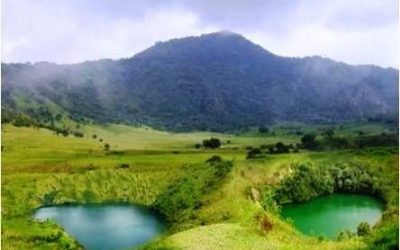ERUDEF TEAM/MINSTRY OF FORESTRY STAFF VISIT SCENE OF GORILLA KILLING IN PINYIN

The Environment and Rural Development Foundation, ERuDeF, in collaboration with the Northwest Regional Delegation of Forestry and Wildlife, NW MINFOF, have launched fresh investigations into the Silver-back gorilla killed March 1, 2013 in Pinyin, a community in Santa subdivision, NW Cameroon.
The rather detailed study commenced March 28, 2013, as ERuDeF CEO, Louis Nkembi and the NW MINFOF Delegate, Mrs. Mbah Grace, led a team of primatologists, collaborators to the Pinyin village.
In a bid to “get from the horse’s mouth” what transpired, the ERuDeF/MINFOF team organized a working session at the Pinyin Fon Palace bringing together the traditional ruler of Pinyin, Fon Ayaba Godfred II and the lady who sighted the gorilla while working in her farm, Mrs. Judith Benue.
During this session, Fon Ayaba gave an account of the circumstances that led to the killing of this human cousin underscoring the fact that the animal was posing lots of threats to his people and the Gendarmerie Commander then gave them the go-ahead. Madam Judith Benue, on her part, narrated how she saw the gorilla, escaped and raised alarm in the village refuting allegations of the rumours that had spread before of rape threat from the gorilla.
The NW Regional Delegate of Forestry and Wildlife, Mrs. Mbah Grace, reacted to these, highlighting the legal implication of the killing of the Silver-back gorilla. The Delegate explained that the silver back gorilla, killed in Pinyin, falls within category ‘A’ of protected animal species alongside Chimpanzees and others. Thus, anybody who kills them is liable to a jail term of 1 to 3 years or a fine of 3 Million francs and above. She used the session to educate the Fon on wildlife and biodiversity conservation.
The CEO and of ERuDeF, Louis Nkembi, in a rather solemn mood, regretted the fact that the villagers and the local authority did not give the administration in charge of forestry and wildlife a chance to rescue this human cousin. He reiterated the fact that the killing of the gorilla has come to further confirm the existence of gorillas in proposed Tofala Wildlife Sanctuary. He cautioned the Fon on the exact action they should take when such a thing happens.
After the working session, Mrs. Benue led the ERuDeF/NW MINFOF team to where she sighted the gorilla and the riparian forest, where the gorilla was finally killed. The distance between these two places was close to 4KM.
From the different sites, ERuDeF/ NW MINFOF team visited the Pinyin Gendarmerie Post. The Gendarmerie Commander, who preferred anonymity said he was he was told the animal was a monkey but refuted mentioning whether he ordered the killing or not.
After the trip, the investigative team visited a taxidermist in Mulang-Bamenda, where the gorilla is under embalmment, and collected hair samples for scientific studies
After the rather exploratory outing , the ERuDeF team holds that the gorilla was killed out of excitement on the part of the Pinyin people and not self defense as has hitherto been reported. They argued that it should have been self defense if Mrs. Benue killed the animal when it was advancing toward her and not after the animal had escaped and sought refuge in a riparian forest several KMs away. In this regard, ERuDeF and the Northwest Forestry and Wildlife Delegation agreed to work closely in sensitizing forest adjacent communities about wildlife conservation and to carry out further studies on the possible existence of other group of gorillas around where the silver back was killed.
By Ndimuh B. Shancho



